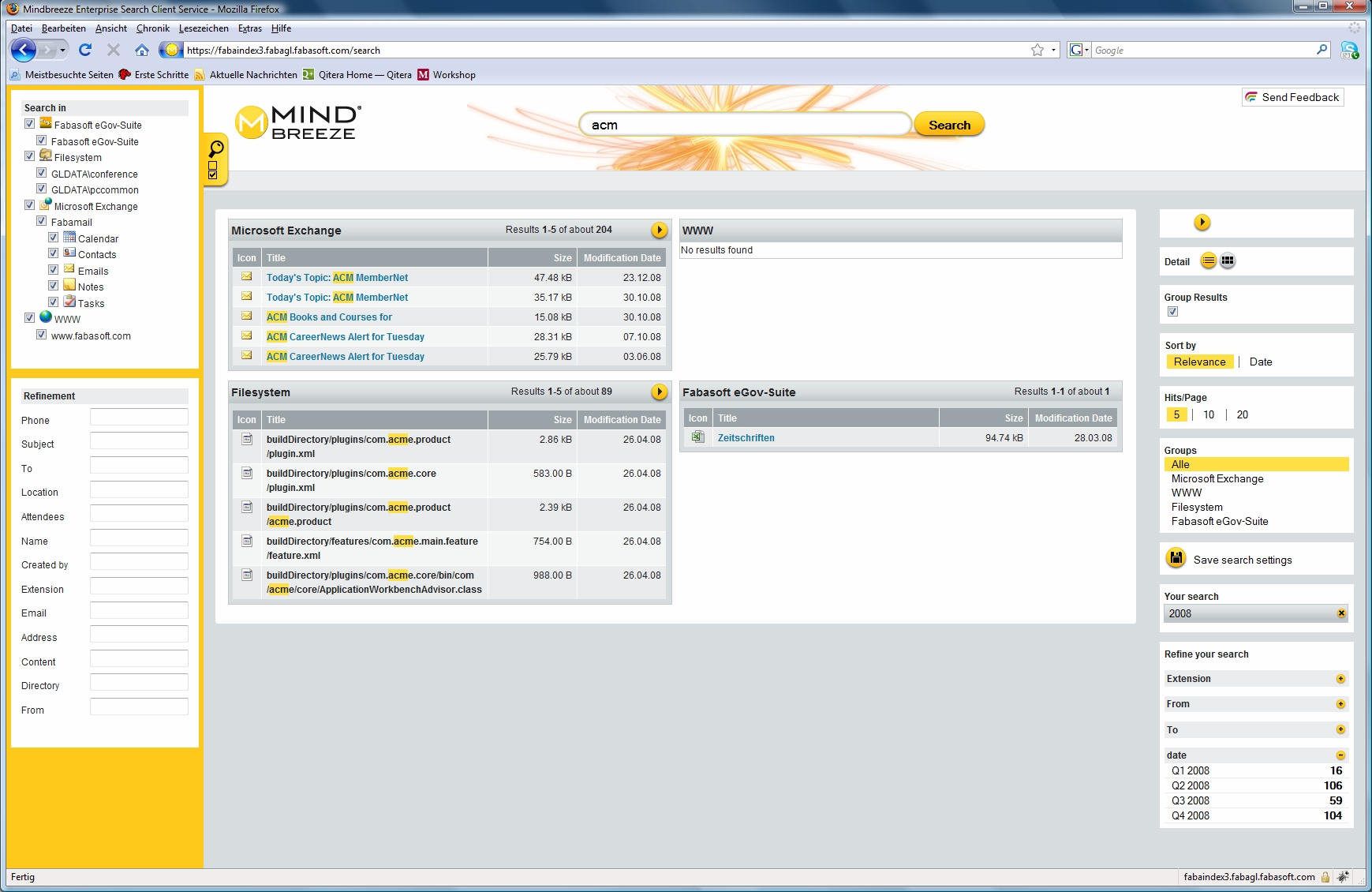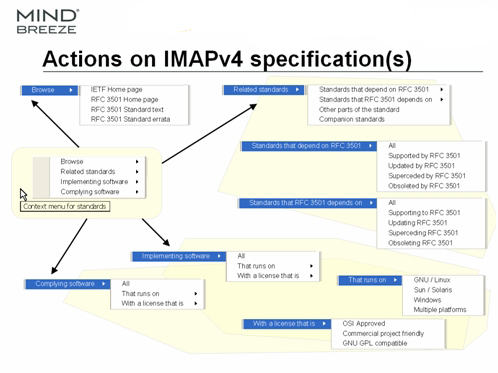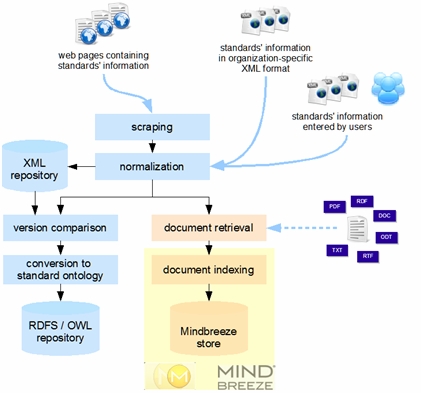Mindbreeze
An Interview with Daniel Fallmann
|
|
Mindbreeze was set up in 2005. The company has an office in Austria and a new US headquarters in Needham, Massachusetts. The firm came on my radar with its intriguing tag line, "Making business information transparent instantly." Most search and content processing systems puzzle users who are not able to locate documents and information that are expected to be in the system. The Mindbreeze approach is to process the available content and keep users productive without having to resort to expensive, frustrating, and time consuming manual queries. What caught my attention was the location of the company in Austria, Linz to be exact. When I think of Austria, I flash on an image of Mozart. After spending time with the Mindbreeze team, I will have to add to my mental images a high-technology company and the pastries from Hotel Schillerpark. I spoke with the managing director of Mindbreeze in the firm's offices at Honauerstrasse 4, 4020 in Linz. |
Thank you for taking the time to speak with me. What's a search company doing in Linz, a town I associate with Mozart's wonderful Symphony No. 36 in C Major?
Math and music seem to be related. We have quite a strong technology sector in Linz. How are you finding the city?
Wonderful. Do you mind if I ask you some questions about your search product Mindbreeze?
No, not at all. I will do my best to answer your questions.
Okay, what's a Mindbreeze?
The term “Mindbreeze” translated from German refers to situations where someone knows certain information exists but can't readily remember exact details - a “Mindbreeze” is what is needed to instantly refresh your mind with the information required. The Mindbreeze tag line "Knowledge is a matter of seconds" reinforces this theme.
What's your background?
I am the founder of Mindbreeze. I hold a Master’s degree in computer science from Johannes Kepler University, Linz, Austria. Before founding Mindbreeze, I worked in systems architecture, systems development, parallel computing and systems management/monitoring. While earning my Masters degree I worked at Fabalabs, a division of Fabasoft Corporation dedicated to ensuring Fabasoft’s products seamlessly run within enterprise-class environments on an open source stack.
What was the trigger in your career that made search and retrieval a focal point? Weren't there other, easier opportunities for you to use your technical training and expertise?
I often compare developing better search solutions to playing chess. You don't choose to play chess if you want to play a game you are able to learn completely in a few hours. I have played chess for more than 20 years now but I have never stopped learning new maneuvers.
As I was born in the early 80's I consider myself to be what Don Tapscott calls, a "digital native." I grew up using all the usual search techniques and meta search engines but continued to find that they were not powerful and simple enough to deliver a superior end user experience. For some reason most solutions haven't improved their end-user ‘experiences’ to keep up with today’s sophisticated searchers. Today we know people are waiting for the next big innovations in information access and really demand more than the "standard" Google-style search box. Users want a flexible "one stop shop" for information within their companies. There are so many possibilities with today's technologies that the most important thing for me is to focus on what users need and demand – and delivering that user experience is my passion.
Please, give me an overview of the Mindbreeze system. Would you start by describing what sets the system apart from other search and content processing vendors' offerings? Let's start with the cost of the system?
That's a good question. Mindbreeze is the only solution priced either per named user or per concurrent user. This delivers incredible flexibility to our customers in terms of total cost of ownership.
What's the architecture of the system?
Mindbreeze Enterprise Search can be downloaded and deployed very easily, complete with a full trial version which allows users to try our solution before making any commitment. The main reason is that we kept our architecture and deployment flexible and simple from the beginning.
How does the system handle relevance and context?
Mindbreeze Enterprise Search is able to handle information in context. Context can be user context, application context, information context, workflow context, or semantic context. This allows us to display a result and enable actions to be taken on that result depending on multiple context dimensions. For example, a Word document result returned from SharePoint can be checked out from a simple click from within the Mindbreeze client. Let me show you a query. [Runs the query ACM. Screen shot below.] You can see our facets and the way we present information in an intuitive way:

Security is an issue with search. What is Mindbreeze's approach to security?
Our Mindbreeze Enterprise Search system uses a high-performance, flexible check of access rights using open IT standards. Thanks to highly innovative tools, existing security in enterprise applications can be applied. The existing rights of the user submitting the inquiry are checked in the process and evaluated during the search. Mindbreeze Enterprise Search delivers only those results that the user is entitled to read or edit at the time of search.
How do you position your system as we approach 2010?
We use the phrase "Strategy 100" that says, " Platform independence and a clear focus on supporting the same functionality running under Linux and Microsoft Windows." So the platform decision is up to our customers and partners.
Let me drill in. What is your " actionable information" and "information in context" about?
We use the phrase "contextual actionable information" to communicate that Mindbreeze Enterprise Search enables users to get enrichments on query results and act upon this information.
What is an "enrichment"?
One can think of an enrichment as context information that is available for every information object and for its metainformation as well. Such enrichments can be requested at filter time and at query time (real-time) and, therefore, Mindbreeze is able to interrelate information from the indices as well as from federated online datasources.
And an action?
Actions can take several forms. First, an action can be based on application-specific tasks, such as clicking to check out a document in Microsoft SharePoint or sending a Word document as a PDF. A user can view a document directly from a results list.
Second, query actions that can be calculated by Mindbreeze Enterprise Search such as faceting of results, drill down, sub queries, and complex query expansion, reasoning based queries.
Can you give me an example of this feature?
Sure, for example, when searching for patient records, Mindbreeze enterprise search does not only provide a list of these records, but enables actions that you can act upon.
Can you show me?
Yes. [reaches for the laptop and runs a query]. So, an action in this case can be controlled by the licensee. Let me give you some examples.
So, if there is a phone number mindbreeze enables you to call the patient or the responsible doctor immediately on the record you found by making use of the known relationships between these objects (patient record, responsible doctor, patient).
And Mindbreeze enterprise search can tell you all patients that take a certain drug or take a combination of several drugs and of course enforces your access rights.
Our navigators, facets, information objects are harmonized over thel datasources and can be enriched with additional context (user, application, workflow) as well.
I think it is important to mention is that we manage information objects and not just text and strings. Our approach makes it possible for the system to interrelate information and take action on those objects. The system knows that an object is a person, for instance.
We also offer actions that work with the meaning of information such as resolving relationships or performing reasoning tasks using our reasoning modules. This is very powerful because this combines the performance and ability to execute complex queries with semantic modules.
What's an example of reasoning?
Let me show you a diagram. Take a look at the following use cases and schematic presentation of the unterlying architecture. [He shows me a screen display reproduced below]

We can deal with use cases that require advanced reasoning. The use case is searching for an imap4 specification in a vertical solution of mindbreeze enterprise search which combines it standards and products.
Do you have a schematic of the reasoning method?
Yes. The schematic-architecture and integration of the reasoning module with Mindbreeze Enterprise Search takes this form:

The number of new companies entering the search and content processing "space" is increasing. What's your view on this crowded market sector?
The marketing aspects of most search vendors are quite often the same, but behind the scenes the "search game" has changed completely in the last ten years. Now there are big differences between the vendors. We often meet with people who run up to five different search solutions and many licensees of some big name systems are quite unhappy with the delivery of rich end-user experiences.
We do business differently. As I said, we offer a free trial download of Mindbreeze Enterprise Search.We want our customers to know what they will be getting and to feel confident that our solution will enable them to work more efficiently.
Of course, users today are familiar with the "search box" and keyword based searches. But, the true value is delivered when an end user receives enriched results that can be acted upon (action-enabled information) to make their everyday jobs more enjoyable and productive.
What are two or three of the key features in Mindbreeze?
Mindbreeze has a very flexible client architecture. A licensee with some knowledge of HTML and Javascript can customize the client for very specific needs. Furthermore our approach enables search-driven mash ups based on our products quite easy to implement. We also have built a strong (query) federation framework that allows to apply context and actions to federated information (results) as well. We have created intelligent, conversational interfaces that enable facets so users can do explorative information access.
There's a push to create mash ups--that is, search results that deliver answers or reports. What's your view of this trend?
Mash ups are in general a very important and powerful trend. We focus on secure mash ups. With the software as a service landscape growing quite fast customers can build powerful "on-top-of" applications with more ease than ever. But one thing that from my point of view needs to be considered quite carefully is open standards to which the vendors have a commitment. One example is "authentication": There is no common way of doing that today, although there are standards in that direction like OpenID and SAML [security assertion markup language] for instance.
Are you supporting other vendors' systems or are you a stand-alone solution?
We support other vendors' software products such as file systems , Microsoft SharePoint, Microsoft Exchange, Novell GroupWise, IBM Lotus Domino/Notes, Web sites (public and private), and data stored in databases (highly structured information). Let me add that we have a very strong query federation capability that brings actions to federated results. Also, we offer other vendors the ability to OEM our technology into their products.
I heard you have several large scale installations with over 10.000 users and many terabytes. What performance tools do you provide to your customers?
One innovation from an infrastructure point of view we did is to use app.strudl Software-Telemetry to monitor Mindbreeze's services in detail.
Just imagine a complex query that a users does and the results take four seconds to come back. As we know that there are many distributed services (Mindbreeze Enterprise Search services) involved to process this query (for example,client services, query services, index services) in the background.
Now, with our app.strudl Software-Telemetry integration, the customer has the ability to track a certain request of a specific user on its way to all these services and the systems tell the administrator how much time is taken in each component and in each step. It is extremely helpful to know exactly where the most time is spent and to take corrective action on any real issues.
What is it that you think people are looking for from semantic technology? Is it richer interface, better content? What are people really looking for?
There is no "one size fits all" strategy in enterprise search, but there is a very good common layer we see at our customers that everyone uses out-of-the-box.
We see that people look for interconnected and interrelated results/information based on what something is about or very often who did something. When thinking about information, we try to conceptualize information in the context of who did something or how someone is connected to certain content. Therefore, it is essential to have information in context. We have from the start of the company put the focus on the user and his need for information access.
What are the hot trends in search for the next 12 to 24 months?
The biggest trend is engaging users with conversational interfaces. It's all about users.
Is there an online demonstration?
Yes, we have put up a number of online demonstrations. You can explore the use of Mindbreeze for Web site search with content from Wikipedia and several other sources.
Where can people get more information?
Of course, www.mindbreeze.com, if you want to know something that's not on our Web site give us a call or contact us via email and we will provide you the information you need shortly.
ArnoldIT Comment
What struck me about the Mindbreeze system was the company's interest in making the product fit the customers' requirements. The indexing speed and the relevance of the results were on a par with systems that cost orders of magnitude more. I found the technical approach taken by the company's engineers sound. New features are queued for release through 2010. Based on the information provided in the briefing Mindbreeze provided, an organization arm wrestling with SharePoint search or struggling to get an appliance solution to deliver more relevant results, Mindbreeze warrants close examination.
Stephen E. Arnold, September 3, 2009

